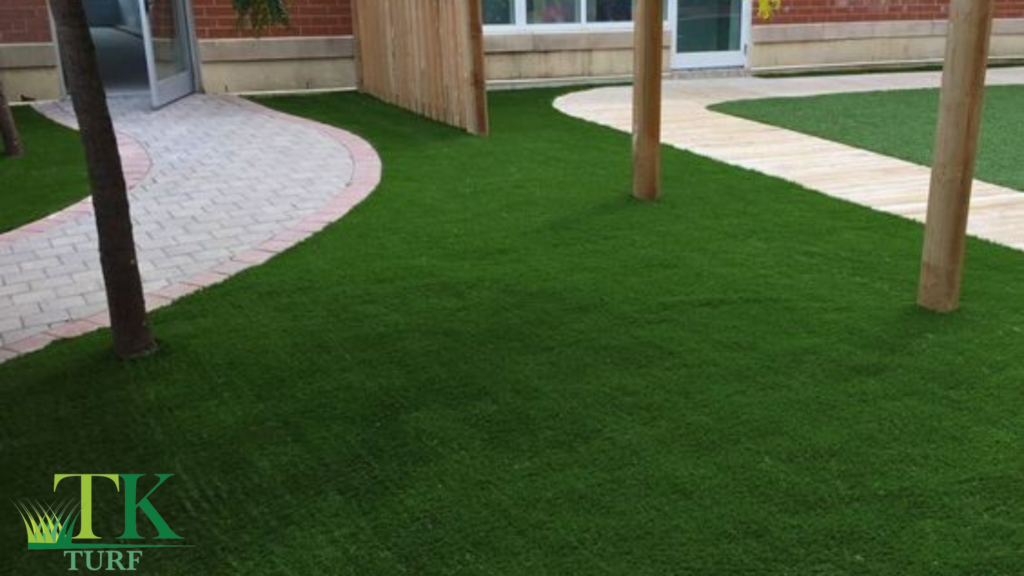In today’s world, more homeowners and businesses are seeking environmentally friendly solutions for their landscaping needs. Synthetic turf is emerging as a top choice for those who want to reduce their environmental impact while maintaining a beautiful, low-maintenance outdoor space. From conserving water to eliminating the need for harmful chemicals, synthetic turf offers a range of environmental benefits that make it an eco-conscious alternative to traditional lawns. In this blog post, we’ll explore how synthetic turf can positively impact the environment and why it’s becoming increasingly popular for both residential and commercial properties.
1. Water Conservation: Saving Thousands of Gallons Annually
One of the most significant environmental benefits of synthetic turf is its ability to conserve water. Traditional lawns require regular watering to stay green and healthy, especially in warm climates. In contrast, synthetic grass requires no watering at all, which can save thousands of gallons of water each year. This is particularly beneficial in areas prone to drought or water restrictions, where conserving water is critical.
By switching to synthetic turf, homeowners and businesses can significantly reduce their water consumption, helping to protect local water supplies and reduce their utility bills.
2. Eliminating the Need for Pesticides and Fertilizers
Maintaining a traditional lawn often involves the use of pesticides, herbicides, and fertilizers to keep grass healthy and free from pests. These chemicals can have harmful effects on the environment, seeping into the soil and contaminating nearby water sources. Synthetic turf eliminates the need for these toxic substances, providing a chemical-free alternative that is safe for the environment, pets, and people.
By choosing synthetic grass, you can create a healthy, green lawn without contributing to soil degradation or water pollution.
3. Reducing Carbon Emissions with Low-Maintenance Landscaping
Another environmental benefit of synthetic turf is its ability to reduce carbon emissions. Traditional grass lawns require regular mowing, often with gas-powered lawnmowers that emit carbon dioxide and other pollutants into the air. Synthetic turf, on the other hand, requires no mowing or trimming, reducing your carbon footprint significantly.
Additionally, because synthetic turf does not need to be watered, fertilized, or treated with chemicals, the overall maintenance is minimal. This results in fewer trips to the hardware store and less reliance on fossil fuels for transportation and landscaping equipment.
4. Preventing Soil Erosion and Runoff
Soil erosion is a common problem with natural lawns, especially in areas that receive heavy rainfall. The constant watering, combined with the wear and tear from foot traffic, can lead to soil degradation and erosion over time. Synthetic turf provides a stable, durable surface that helps prevent soil erosion, even during periods of heavy rain.
In addition, synthetic turf can help reduce water runoff. Traditional lawns often contribute to runoff, which can carry pesticides, fertilizers, and other pollutants into local waterways. Synthetic turf allows water to filter through drainage systems, helping to minimize runoff and its harmful effects on the environment.
5. Longevity and Sustainability: A Long-Term Investment
While the initial installation of synthetic turf may require an upfront investment, its long-term environmental benefits make it a sustainable choice. Synthetic turf is designed to last 15 to 20 years or more, depending on usage and maintenance. This longevity reduces the need for frequent replanting, reseeding, or lawn replacements, further minimizing waste and resource use.
By choosing a long-lasting, sustainable landscaping option like synthetic turf, homeowners and businesses can make a positive impact on the environment while enjoying a green, beautiful lawn year-round.
6. Heat Island Reduction in Urban Areas
In densely populated urban areas, natural grass lawns and green spaces can help reduce the heat island effect, which occurs when cities absorb and retain heat from buildings, roads, and other infrastructure. Synthetic turf, especially newer models with cooling technology, can also contribute to reducing heat absorption in urban environments. This makes it an excellent option for rooftop gardens, patios, and other urban spaces where maintaining a traditional lawn is impractical.
By installing synthetic turf, urban areas can enjoy the aesthetic and functional benefits of green spaces while minimizing heat absorption and reducing the overall temperature of the surrounding area.
Conclusion
Synthetic turf offers a wide range of environmental benefits, from conserving water to eliminating the need for harmful chemicals and reducing carbon emissions. Its durability, low-maintenance nature, and ability to prevent soil erosion make it a smart choice for eco-conscious homeowners and businesses. By choosing synthetic turf, you not only create a beautiful, lush landscape but also make a positive impact on the environment.
If you’re looking for a sustainable landscaping solution that benefits both you and the environment, consider synthetic turf for your property. Contact a professional installation company today to learn more about the options available and how this eco-friendly alternative can enhance your outdoor space.


Recent Comments